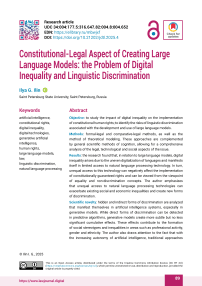Constitutional-Legal Aspect of Creating Large Language Models: the Problem of Digital Inequality and Linguistic Discrimination
Автор: Ilin I. G
Журнал: Journal of Digital Technologies and Law @lawjournal-digital
Статья в выпуске: 3 (1), 2025 года.
Бесплатный доступ
Objective: to study the impact of digital inequality on the implementation of constitutional human rights; to identify the risks of linguistic discrimination associated with the development and use of large language models. Methods: formal-legal and comparative-legal methods, as well as the method of theoretical modeling. These approaches are complemented by general scientific methods of cognition, allowing for a comprehensive analysis of the legal, technological and social aspects of the issue. Results: the research found that, in relation to large language models, digital inequality arises due to the uneven digitalization of languages and manifests itself in limited access to natural language processing technology. In turn, unequal access to this technology can negatively affect the implementation of constitutionally guaranteed rights and can be viewed from the viewpoint of equality and non-discrimination concepts. The author emphasizes that unequal access to natural language processing technologies can exacerbate existing social and economic inequalities and create new forms of discrimination. Scientific novelty: hidden and indirect forms of discrimination are analyzed that manifest themselves in artificial intelligence systems, especially in generative models. While direct forms of discrimination can be detected in predictive algorithms, generative models create more subtle but no less significant cumulative effects. These effects contribute to the formation of social stereotypes and inequalities in areas such as professional activity, gender and ethnicity. The author also draws attention to the fact that with the increasing autonomy of artificial intelligence, traditional approaches to discrimination detection are becoming less effective, which requires the development of new analysis and regulation methods. Practical significance: the results provide a basis for identifying and assessing the legal risks associated with unequal access to digital products using natural language processing. This contributes to the improvement of legal regulation in the field of the development and use of artificial intelligence technologies. The article offers recommendations for lawmakers, regulators, and technology developers aimed at minimizing the risks of digital inequality and linguistic discrimination.
Artificial intelligence, constitutional rights, digital inequality, digital technologies, generative artificial intelligence, human rights, large language models, law, linguistic discrimination, natural language processing
Короткий адрес: https://sciup.org/14131899
IDR: 14131899 | УДК: 34:004:177.5:316.647.82:004.8:004.652 | DOI: 10.21202/jdtl.2025.4


